
Jaime Camil: My guide to Mexico’s Day of the Dead
By Josué Corro
The annual holiday honoring lost loved ones is an experience you’ll never forget. One of Mexico’s biggest stars, actor Jaime Camil, shares how he and his family will be celebrating
Day of the Dead, or Día de Muertos, “isn’t just about remembering loved ones who have passed away,” says Mexican actor, singer and television presenter Jaime Camil. “It’s about never forgetting them—it has a deeper and more beautiful meaning for our culture.”
One of his country’s biggest stars, Camil divides his career and family life between Mexico, where he hosts talent show La Academia on Azteca Uno, and Los Angeles, where he lives with his wife and children. His is a truly cross-cultural resume, including Jane the Virgin and the Spanish-language version of Coco, the 2017 Pixar film that helped Día de Muertos become a globally recognized celebration.
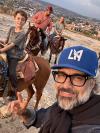
Off the beaten track: Camil and family in San Miguel de Allende
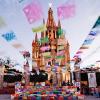
The town celebrates in style
“It’s a cornerstone of Mexican and Latin culture—embraced by countries like El Salvador, Colombia and Guatemala. Even American culture is showing increased understanding and adoption,” Camil observes.
Celebrated predominantly on November 1 and 2 each year (though other days from October 31 to November 6 may be included, depending on the locality), Día de Muertos sees cemeteries become seas of marigolds as families gather to honor their departed.
6 Día de Muertos tips for travelers
Plan ahead
Mexico offers a great diversity of Día de Muertos celebrations—from Mexico City to localities like Oaxaca or Pátzcuaro in Michoacán, the streets are filled with color, music and tradition. Be sure to plan ahead: Some hotels are booked months in advance.
Check your dates
Fusing pre-colonial and Catholic beliefs, this festivity is typically observed on November 1 and 2 (though, depending on where you are, other days from October 31 through November 6 may be included). Cemeteries are filled with vibrant marigold flowers as families gather to honor their deceased loved ones. You can visit cemeteries, take photos (ask subjects’ permission), and even listen to mariachi bands playing throughout the day.
Appreciate ofrendas
At the heart of this celebration lie the ofrendas, or altars. These are meticulously crafted displays adorned with photographs, cherished possessions, and favorite foods and beverages of the departed. Candles, colorful paper cutouts and marigolds are also displayed.
Embrace costumes
Día de Muertos traditionally focuses on remembrance and reflection. However, in recent times some communities have incorporated elements of Halloween. Children dress up as their favorite pop-culture characters and go trick-or-treating, chanting “¿Me da mi calaverita?” (“Can I have my little skull?”)—a playful request for the candy skulls that adorn the traditional ofrenda.
Meet La Catrina
The character of La Catrina (also known as “The Elegant Skull”) traces its origins to an etching created by the artist José Guadalupe Posada, and appears in the murals of Diego Rivera. Today, La Catrina is a universal symbol of Día de Muertos, brought to life through colorful, ornate dresses, intricate hairstyles adorned with flowers, and the iconic black-and-white skull makeup.
Try bread of the dead
Food also plays a fundamental role. Pan de muerto, with its characteristic bones and skull decorations, is a quintessential treat enjoyed during this period. Its rich flavor is perfectly complemented by a cup of hot chocolate.
Rather than a time of sorrow or grief, it’s a joyous occasion to commemorate and celebrate the lives of those gone before us, with parades, festivals and lively comparsas (processions featuring dance and music) held in cities and towns across Mexico. (Scroll down to see our guide to the best places to travel.)
Tradition dictates that, during these days, the souls of the departed return to the earthly realm to visit their families, and the celebration extends beyond burial grounds, becoming a personal ritual filled with cherished memories. Families place altars in their homes, adorned with photographs, food, and objects that evoke memories of their loved ones.
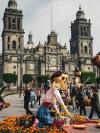
La Caterina makes an appearance at Mexico City’s Metropolitan Cathedral
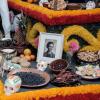
Altars are lined with food, flowers, photos and sentimental objects

Experience Día de Muertos
Find flights and stays for a memorable Day of the Dead giveaway.
This year is, in fact, the first time that Camil will be joining public events, traveling to Oaxaca and documenting the experience for Expedia’s Instagram. “Although my family erected an altar each year, this is the first time I’m delving into the profound beauty and meaning that it has in my country, to truly immerse myself in this tradition,” he says.
And while Día de Muertos might be deeply ingrained in Latin American heritage, its core message of love and remembrance resonates universally. As Camil concludes, “True death occurs when someone leaves your heart—not when they depart from this world.”
5 places to experience Día de Muertos

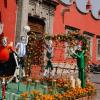

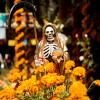
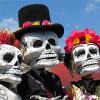







Jaime Camil’s Travel Shop
See Jaime’s “Día de Muertos in Mexico” collection for a selection of his favorite stays

Josué Corro is editor-in-chief of Dónde Ir, Mexico’s biggest lifestyle guide, and host of Filmsteria, one of Latin America’s most listened-to movie podcasts. He is also a contributor for Esquire, GQ, Travel & Leisure, and Elle.
